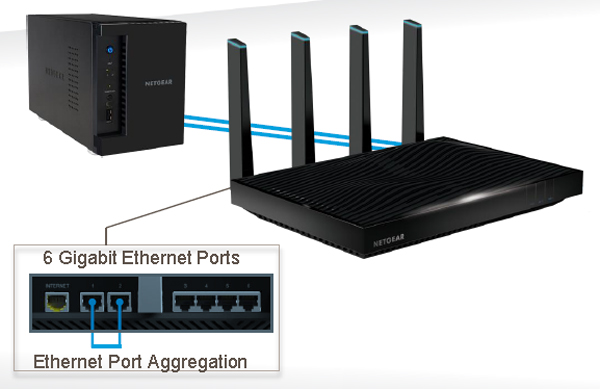Netgear Debuts Nighthawk AC5300 Wireless Router With MU-MIMO On The Horizon
UPDATE: Pricing and availability information added.
Netgear has released the Nighthawk X8 AC5300 Smart Wi-Fi Router, its most powerful router to date and the fourth product in the company's series of Nighthawk routers. According to Netgear, this new router is its high-end solution to problems caused by the increasing number of devices popping up in today's home networks. The Nighthawk X8 comes with a set of features designed to give tech enthusiasts increased range and performance.
The Nighthawk X8 is a tri-band AC5300 wireless router that can deliver network speeds of up to 1000 Mbps for the 2.4 GHz band, and 2166 Mbps for its two 5 GHz bands.
For processing, the router uses Broadcom's 40 nm-based BCM4709 communications processor with a 1.4 GHz ARM Cortex-A9 dual-core at the heart of its microstructure, and a BCM4366 SoC that gives the router its 802.11ac tri-band support.
Connectivity-wise, the Nighthawk X8 includes one WAN/Internet port and six gigabit Ethernet ports on the back of the router, eight antennas (four internal and four external), and two USB ports (3.0 and 2.0).
The Nighthawk X8 is also capable of connecting to NAS devices that support dual port aggregation. By using two ports on the router and on the NAS, a consumer can get better throughput in order to watch stored content, such as 4K video, sitting on the connected storage device.
The Nighthawk X8 is also MU-MIMO capable. This means that the router has the physical architecture to support the Wireless AC Wave 2 technology, but MU-MIMO support won't be available until later this year when Netgear enables it as part of a future firmware update. Once updated, the router can reap from the benefits of MU-MIMO and increase the number of clients that simultaneously connect to it.
Get Tom's Hardware's best news and in-depth reviews, straight to your inbox.
With the Nighthawk X8, Netgear introduced its Active Antenna technology into the higher-end router scene. According to Netgear, the new antenna technology changes the way that external antennas are powered by the router. By bypassing the router's PCB, each antenna will benefit from better noise cancelling, reduced interference, and better signal direction, but at the same time, it won't pull additional power draw from the power source. This new antenna tech may help in performance, but it may also hurt a little when it comes to cost. Netgear explained that it's reserving Active Antenna for its high-end wireless products, as the technology's inclusion is a significant contribution to this device's, and upcoming products', final price.
Smart Connect is a feature that lets the router intelligently assign wireless devices to an appropriate Wi-Fi band. By knowing to put older devices on the slower band, the Nighthawk X8 can keep slower devices off of the faster networks, thus letting fast devices work faster.
Two additional features that are highlighted on the Nighthawk X8 are load balancing and Dynamic QoS. The load balancing feature is tied to the router's two 5 GHz bands and lets wireless users connect to the 5 GHz band with the best availability. Dynamic QoS allows a user to allocate bandwidth to specific applications and helps shape network traffic to wireless devices.
When asked about open source support, Netgear stated it will have the first release of the open source firmware ready and available for the Nighthawk X8 at myopenrouter.com, the company's open source community website.
Other Nighthawk X8 features include remote management and access via Netgear’s genie app, enhanced parental control, and ReadyCloud which allows the user to attach USB storage to the Nighthawk X8 and access it from most anywhere through a web enabled device.
The Netgear Nighthawk X8 AC5300 Smart WiFi Router is available now and can be purchased online and in stores for an MSRP of $399.99 US.
Follow us @tomshardware, on Facebook and on Google+.
-
SirGCal Nice, my ASUS RT-AC66u won't stay connected for 24 hours anymore... Self Reboots... Although going back to older firmware stabilized it a tiny bit...Reply -
xenol Ugh, I hate how wireless routers advertise their aggregate network speeds. Let me know when we have a wireless adapter that can use those aggregate speeds.Reply -
Avus To me, these are all inflated numbers. Numbers sell are still the main game for selling stuff.Reply -
ammaross ReplyNice, my ASUS RT-AC66u won't stay connected for 24 hours anymore... Self Reboots... Although going back to older firmware stabilized it a tiny bit...
That's the metric I'd like to see in ALL wifi router reviews: How many weeks it stays alive with wifi devices heavily burdening the antenna. So far, I've caused Netgear and Linksys routers to overheat their wifi chip to the point the wifi stops working (they still pass packets on the wired side though) and only a reboot brings the wifi back. There's several tutorials on how to rig up fans to actively cool the wifi chips in Netgear devices.... -
Darkk Although I am pretty happy with my Asus RT-AC68U used only as an access point and it never needs rebooting.Reply
Am curious about the real world performance with this new monster. -
PhilJSmith67 Does anyone know if this AC5300 allows the use of more 5GHz channels than the typical 36,40,44,48 and 149,153,157,161? I've had a Versatek AP-300N for a couple years and it also covers 100,104,108,112,116,120 as usable channels, and all but one of my devices will use them. These are legal to use in the US per FCC, and more recently channels 68 through 96 were opened up by the FCC. The problem with the first two groups of channels I mentioned is that with 80MHz channel bonding, you only have two channels (36-48 or 149-161), which are already overcrowded in my area.Reply


